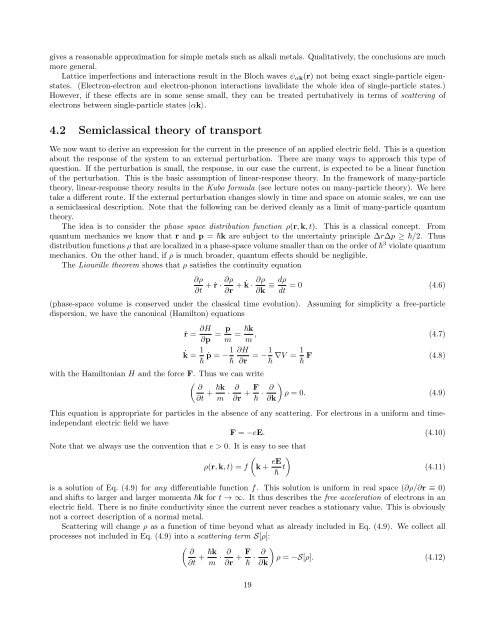Carsten Timm: Theory of superconductivity
Carsten Timm: Theory of superconductivity
Carsten Timm: Theory of superconductivity
You also want an ePaper? Increase the reach of your titles
YUMPU automatically turns print PDFs into web optimized ePapers that Google loves.
gives a reasonable approximation for simple metals such as alkali metals. Qualitatively, the conclusions are much<br />
more general.<br />
Lattice imperfections and interactions result in the Bloch waves ψ αk (r) not being exact single-particle eigenstates.<br />
(Electron-electron and electron-phonon interactions invalidate the whole idea <strong>of</strong> single-particle states.)<br />
However, if these effects are in some sense small, they can be treated pertubatively in terms <strong>of</strong> scattering <strong>of</strong><br />
electrons between single-particle states |αk⟩.<br />
4.2 Semiclassical theory <strong>of</strong> transport<br />
We now want to derive an expression for the current in the presence <strong>of</strong> an applied electric field. This is a question<br />
about the response <strong>of</strong> the system to an external perturbation. There are many ways to approach this type <strong>of</strong><br />
question. If the perturbation is small, the response, in our case the current, is expected to be a linear function<br />
<strong>of</strong> the perturbation. This is the basic assumption <strong>of</strong> linear-response theory. In the framework <strong>of</strong> many-particle<br />
theory, linear-response theory results in the Kubo formula (see lecture notes on many-particle theory). We here<br />
take a different route. If the external perturbation changes slowly in time and space on atomic scales, we can use<br />
a semiclassical description. Note that the following can be derived cleanly as a limit <strong>of</strong> many-particle quantum<br />
theory.<br />
The idea is to consider the phase space distribution function ρ(r, k, t). This is a classical concept. From<br />
quantum mechanics we know that r and p = k are subject to the uncertainty principle ∆r∆p ≥ /2. Thus<br />
distribution functions ρ that are localized in a phase-space volume smaller than on the order <strong>of</strong> 3 violate quantum<br />
mechanics. On the other hand, if ρ is much broader, quantum effects should be negligible.<br />
The Liouville theorem shows that ρ satisfies the continuity equation<br />
(phase-space volume is conserved under the classical time evolution).<br />
dispersion, we have the canonical (Hamilton) equations<br />
∂ρ<br />
∂t + ṙ · ∂ρ<br />
∂r + ˙k · ∂ρ<br />
∂k ≡ dρ<br />
dt = 0 (4.6)<br />
Assuming for simplicity a free-particle<br />
ṙ = ∂H<br />
∂p = p m = k m , (4.7)<br />
˙k = 1 ṗ = − 1 ∂H<br />
∂r = − 1 ∇V = 1 F (4.8)<br />
with the Hamiltonian H and the force F. Thus we can write<br />
( ∂<br />
∂t + k m · ∂<br />
∂r + F )<br />
· ∂<br />
ρ = 0. (4.9)<br />
∂k<br />
This equation is appropriate for particles in the absence <strong>of</strong> any scattering. For electrons in a uniform and timeindependant<br />
electric field we have<br />
F = −eE. (4.10)<br />
Note that we always use the convention that e > 0. It is easy to see that<br />
ρ(r, k, t) = f<br />
(k + eE )<br />
t<br />
(4.11)<br />
is a solution <strong>of</strong> Eq. (4.9) for any differentiable function f. This solution is uniform in real space (∂ρ/∂r ≡ 0)<br />
and shifts to larger and larger momenta k for t → ∞. It thus describes the free acceleration <strong>of</strong> electrons in an<br />
electric field. There is no finite conductivity since the current never reaches a stationary value. This is obviously<br />
not a correct description <strong>of</strong> a normal metal.<br />
Scattering will change ρ as a function <strong>of</strong> time beyond what as already included in Eq. (4.9). We collect all<br />
processes not included in Eq. (4.9) into a scattering term S[ρ]:<br />
( ∂<br />
∂t + k )<br />
m ·<br />
ρ = −S[ρ]. (4.12)<br />
∂<br />
∂r + F ·<br />
19<br />
∂<br />
∂k

















